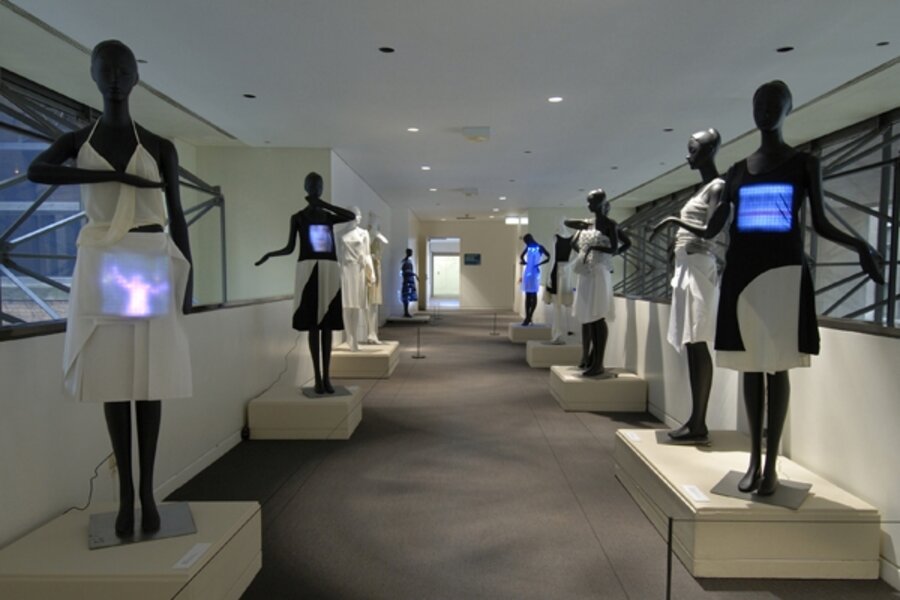Interactive fashion lets costumers wear devices on their sleeves
Loading...
| Chicago
The solar panel in your winter coat warms your back. An LED light on your skirt warns passers-by to give you room on the sidewalk. The display on your eyeglasses flashes the temperature after you slip them on.
Already hanging in designers’ studios, these curious clothes may soon make their way into America’s wardrobe. Interactive fashion, the intersection of electronics and apparel, is a relatively new school of design. Engineers and couturiers, two parties that previously knew little about each other, are locked in intense collaborations today to reshape the role clothing plays in daily life.
As modern culture embraces mobile phones in our pockets, Bluetooth headsets in our ears, and Nike odometers in our shoes, the logical next step is wearing devices on our sleeves, says Tiffany Holmes, chair of the art and technology department at the School of the Art Institute of Chicago, one of the few schools in the United States that offers classes on wearable technology.
“Fashion is about the latest trends and styles, so it really makes a lot of sense this is happening now,” she says.
As Ms. Holmes sees it, with young consumers wearing white headphones as often as earrings, they will soon require apparel to streamline their digital needs.
“One of the things about Western culture is, if we have access to information that is deliverable to our bodies, we will want that,” says Holmes. “Changes in clothing are not that far off.”
Interactive fashion has been around for as long as kids’ shoes came with blinking lights in their soles and sportswear featured hidden pockets for music players.
Newer examples include a T-shirt from thinkgeek.com that detects nearby wireless Internet signals. The logo on the front of the shirt changes as Wi-Fi connection strength waxes and wanes.
But all of these were destined to be marketplace novelties until technology shrunk. While the Wi-Fi T-shirt wants you to tuck a AAA battery box under your belt, new computer chips with the dimensions of a fingernail are now tailor-made for textiles.
For older consumers who grew up with rabbit ears atop their giant Zenith TVs, the idea of interacting with your favorite pair of pants may seem hard to swallow. But to consumers who regularly stream YouTube clips on their iPhones, the evolution of digital-ready clothing is not so far-fetched.
“You’re going to see more clothes marketed to the younger generation because the technology is so much a part of their life that fashion needs to reflect that,” says Beth Wilson, a writer for Women’s Wear Daily.
While the applications remain in the infancy stage, interest in the fashion community is building as designers see this field as a sort of last chance to revolutionize their industry.
Replacing threads with cords, however, requires some serious rethinking. Electronicsmakers such as Philips, Bluetooth, Motorola, and Apple are funding research projects to discover, for instance, just how much optical fiber can be sewn into a sweater before it stops feeling like a sweater. Reevaluating comfort against function is a chief concern of this trend.
For fashion, the floodgate moment will come once someone figures out how to change a computer’s unyielding aversion to water so that it can be washed and worn without difficulty or discomfort.
“The challenges really are in certain electronic components. Transistors have not become soft yet,” says Margarita Benitez, who will teach the inaugural course on interactive weaving at Chicago’s Art Institute this fall.
Ms. Benitez is like many designers who have shifted from making one-of-a-kind art objects that question society – a necklace she designed called the “Detect Protect” warns the wearer of electro-magnetic fields – to becoming laboratory tinkers working to see their ideas mass-produced.
In 2006, she worked with The Jacquard Center, a textile research lab in Hendersonville, N.C., to develop a loom that can generate fabric based on video imagery from a computer feed.
“The textiles that work best with electronics are weaving and surface embroidery,” because the cables can be incorporated naturally into the piece, rather than bolted on later, she says. “In just the same way you can quilt, you can implement components within textiles.”
Having designers rethink sewing as coding takes extreme patience and a willingness to collaborate, says Younghui Kim, a self-described “interactive wearable media artist” in New York who teaches at Hongik University in Korea.
Ms. Kim is a rarity in the fashion world: She became interested in design only after working for years in telecommunications. Staring at computer screens all day created “a really strong need to design something [she] could feel or touch.”
“So I started picking up sewing machines and fabrics, and I designed like a software engineer,” she says. At the time, around 2002, it was frustrating for her to see designers make interactive clothing that was functional, rather than beautiful or comfortable.
She created “HearWear,” a series of couture skirts laden with sensors that trigger illuminating wires depending on how loud the area is. The skirt becomes “a city ear painting,” she says.
Of course, as Apple showed with personal computers, a stylish product will primarily appeal to luxury-minded consumers before hitting the racks at Target.
Chicago designer Anke Loh worked with the electronics company Philips in 2006 to create “Lumalive textiles” that animate simple dresses with moving images or text. She is now working with engineers between London and Chicago to find ways the concept can have street appeal.
“I still think to put lighting in ready-to-wear garments has still not yet been explored enough,” says Ms. Loh. “Incorporating light or sound into clothing is to find the possibilities to make it attractive. So it looks more natural [and not] like a stop light.”





